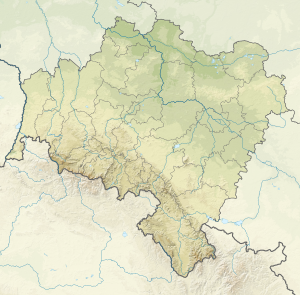Neidburg
| Neidburg | ||
|---|---|---|
| Alternative name (s): | Zamek Rajsko | |
| Creation time : | Late medieval | |
| Castle type : | Hilltop castle | |
| Conservation status: | ruin | |
| Place: | Zapusta | |
| Geographical location | 51 ° 2 '2 " N , 15 ° 19' 55.9" E | |
|
|
||
The Neidburg ( Polish: Zamek Rajsko ) is a ruined castle in Zapusta (German Voglsdorf ) in the rural community of Olszyna ( Mittel Langenöls ) in the powiat Lubański in the Lower Silesian Voivodeship in Poland . The ruin is on the right bank of the Queis above the Marklissa dam . Historically, the Neidburg belonged to the Duchy of Schweidnitz-Jauer .
history
The Neidburg was built in the second half of the 13th century during the reign of the Schweidnitz Duke Bolko I. Together with the Greiffenstein Castle , it served to protect the western border of the Duchy of Schweidnitz-Jauer from the Upper Lusatia . During the Hussite Wars , the Neidburg was conquered and destroyed.
In 1863, Alexander von Minutoli bought the ruins of the castle , who already owned the nearby Friedersdorf Castle . From 1875 to 1878 he had a castle built in neo -Gothic style on the foundations of the ruins , whereby the stone cellars, sand and marble stucco and other components that were still in existence were integrated into the castle building. Since Alexander von Minutoli was a great art lover and collector, he put in the renewed castle rooms a. a. a rich collection of glass, ceramics and paintings. In addition, a stone staircase was laid to the bank of the Queis, which is still preserved today. After Alexander von Minutoli's death in 1887, his daughter Anna von Minutoli became the heir of his possessions. Widowed, she married the Africa researcher Joachim Graf von Pfeil and Klein Ellguth in 1894 , who used the castle as a museum for his collections until 1919.
In 1918/1919 insurgents devastated the facility. Subsequently, Count Joachim von Pfeil donated them to the Association of German Youth Hostels . He converted it into a youth hostel in 1924–1925 by the Görlitzer architect Stange and named it “Graf-Joachim-Pfeil-Jugendherberge”. After the transition to Poland in 1945 as a result of World War II , the castle was looted and fell into ruins. It is currently in private hands and is used for tourism purposes.
Building description
The complex comprised a main building with stepped gables , accessible via a keel arch portal , a keep-like observation tower and a kennel . A polygonal extension was built on a lower rock step towards the lake .
literature
- Arne Franke (Hrsg.): Small cultural history of the Silesian castles . tape 1 . Bergstadtverlag Wilhelm Gottlieb Korn, 2015, p. 255 .
- Dehio Handbook of Art Monuments in Poland. Silesia. Deutscher Kunstverlag, Munich et al. 2005, ISBN 3-422-03109-X , p.

